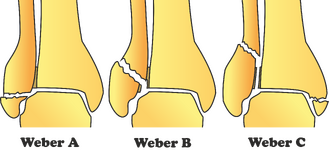Ankle fractures
Ankle fractures are exclusively intra-articular fractures, which are most often caused by indirect violence (sprain - supination, pronation, rotation) and are usually associated with damage to the ankle joint ligaments (distension, partial rupture , total rupture). These ligaments include:
- lig. talofibulare anterius, lig. calcaneofibulare, lig. talofibulare posterius – supination
- lig. deltoideum - pronation (however, this ligament is stronger and resists);
There is poor skin coverage in the ankle area, so these fractures are often open; in those who are closed, devitalization of the skin sometimes occurs due to the pressure of fragments (urgent requirement for early reduction).
The following are important for the stability of the ankle joint:
- fibula length,
- solid tibio-fibular syndesmosis,
- collateral ligaments
Classification[edit | edit source]
- According to Weber (AO classification (44), according to relation to syndesmosis):
- A – the fibula is broken 'under the syndesmosis (transverse fracture), the syndesmosis is intact (stable fracture); the inner ankle can also be broken (bimalleolar fracture);
- B – fibula broken 'in the region of the syndesmosis (oblique fracture), always injured inner ankle and deltoid ligament, syndesmosis injured in 80% (potentially unstable fracture);
- C – fibula broken above the syndesmosis, which is always injured, always the inner ankle (sometimes also the posterior edge of the tibia - Volkmann's, more correctly Earl's triangle - trimalleolar fracture); with a high injury to the fibula, the interosseous membrane tears - the higher the tear extends, the greater the tibiofibular fork spacing - Maisonneuve fracture (unstable, luxating fracture).
- According to Lauge-Hansen' (according to the mechanism of formation):
- supination inverse,
- supinately adducted,
- pronation eversion,
- pronation abductor.
Diagnostics[edit | edit source]
- Clinically: pain, swelling, hematoma, restriction of movement, or palpable fragment and fracture line, broken skin cover (open)
- X-ray: an image of the calcaneus and the base of the fifth metatarsal, the proximal diaphysis of the fibula is also necessary (possibility of a Maissonneuve fracture)
Therapy[edit | edit source]
The main goal of the treatment is to restore the correct length and axis of the fibula (a shortened fibula predisposes to the development of arthrosis), reconstruction of the fork of the ankle joint, restoration of "congruence" of the joint surfaces, prevention of insufficiency of collateral ligaments.
Conservative[edit | edit source]
- simple fractures without dislocation (Weber A) - dorsal and U-splint, after swelling of the circular cast.
Operative[edit | edit source]
- dislocated fractures (Weber B + C) or non-dislocated with reduced skin vitality - osteosynthesis:
- malleolar screw with washer, tension cerclage on two K-wires (for broken off inner ankle),
- splint (for fibula fracture),
- ensuring "syndesmosis" - cortical screw, Mlčoch's loop,
- reconstruction of collateral ligaments (primary suture).
Links[edit | edit source]
Related articles[edit | edit source]
Literature[edit | edit source]
- KOUDELA, Karel, et al. Ortopedická traumatologie. 1. edition. Praha : Karolinum, 2002. 147 pp. ISBN 80-246-0392-6.
- POKORNÝ, Vladimír, et al. Traumatologie. 1. edition. Praha : Triton, 2002. 307 pp. ISBN 80-7254-277-X.

